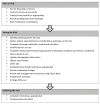Advancing Pharmacy Practice through an Innovative Ambulatory Care Transitions Program at an Academic Medical Center
- PMID: 32178259
- PMCID: PMC7151695
- DOI: 10.3390/pharmacy8010040
Advancing Pharmacy Practice through an Innovative Ambulatory Care Transitions Program at an Academic Medical Center
Abstract
Hospital readmissions are common and often preventable, leading to unnecessary burden on patients, families, and the health care system. The purpose of this descriptive communication is to share the impact of an interdisciplinary, outpatient clinic-based care transition intervention on clinical, organizational, and financial outcomes. Compared to usual care, the care transition intervention decreased the median time to Internal Medicine Clinic (IMC) or any clinic follow-up visit by 5 and 4 days, respectively. By including a pharmacist in the hospital follow-up visit, the program significantly reduced all-cause 30-day hospital readmission rates (9% versus 26% in usual care) and the composite endpoint of 30-day health care utilization, which is defined as readmission and emergency department (ED) rates (19% versus 44% usual care). Over the course of one year, this program can prevent 102 30-day hospital readmissions with an estimated cost reduction of $1,113,000 per year. The pharmacist at the IMC collaborated with the Family Medicine Clinic (FMC) pharmacist to standardize practices. In the FMC, the hospital readmission rate was 6.5% for patients seen by a clinic-based pharmacist within 30 days of discharge compared to 20% for those not seen by a pharmacist. This transitions intervention demonstrated a consistent and recognizable contribution from pharmacists providing direct patient care and practicing in the ambulatory care primary care settings that has been replicated across clinics at our academic medical center.
Keywords: ambulatory care; care transitions; hospital follow-up; medication reconciliation; pharmacist; primary care.
Conflict of interest statement
The authors declare no conflict of interest.
Figures
Similar articles
-
Impact of pharmacist intervention in conjunction with outpatient physician follow-up visits after hospital discharge on readmission rate.Am J Health Syst Pharm. 2015 Jun 1;72(11 Suppl 1):S36-42. doi: 10.2146/sp150011. Am J Health Syst Pharm. 2015. PMID: 25991594
-
Project EVADE: Evaluating the effects of a pharmacist-run transitions of care clinic on hospital readmissions.J Am Pharm Assoc (2003). 2020 May-Jun;60(3):503-508. doi: 10.1016/j.japh.2019.11.012. Epub 2019 Dec 19. J Am Pharm Assoc (2003). 2020. PMID: 31866388
-
Impact of ambulatory care pharmacist intervention on 30-day readmission rates in high-risk transitions-of-care patients.J Am Pharm Assoc (2003). 2023 Nov-Dec;63(6):1694-1699. doi: 10.1016/j.japh.2023.05.005. Epub 2023 May 9. J Am Pharm Assoc (2003). 2023. PMID: 37169256
-
Impact of pharmacist involvement in the transitional care of high-risk patients through medication reconciliation, medication education, and postdischarge call-backs (IPITCH Study).J Hosp Med. 2016 Jan;11(1):39-44. doi: 10.1002/jhm.2493. Epub 2015 Oct 5. J Hosp Med. 2016. PMID: 26434752 Clinical Trial.
-
Evaluating Pharmacist-Led Heart Failure Transitions of Care Clinic: Impact of Analytic Approach on Readmission Rate Endpoints.Curr Probl Cardiol. 2023 Feb;48(2):101507. doi: 10.1016/j.cpcardiol.2022.101507. Epub 2022 Nov 17. Curr Probl Cardiol. 2023. PMID: 36402220 Review.
Cited by
-
Clinical and economic effectiveness of a pharmacy and primary care collaborative transition of care program.J Am Pharm Assoc (2003). 2023 Nov-Dec;63(6):1722-1730.e3. doi: 10.1016/j.japh.2023.08.014. Epub 2023 Aug 21. J Am Pharm Assoc (2003). 2023. PMID: 37611896 Free PMC article. Clinical Trial.
-
Impact of systematic medication review in emergency department on patients' post-discharge outcomes-A randomized controlled clinical trial.PLoS One. 2022 Sep 19;17(9):e0274907. doi: 10.1371/journal.pone.0274907. eCollection 2022. PLoS One. 2022. PMID: 36121830 Free PMC article. Clinical Trial.
-
Exploring the suitability of a ward-based clinical pharmacy activity collection tool for ambulatory care practice: a mixed-methods study.Int J Clin Pharm. 2025 Feb;47(1):166-177. doi: 10.1007/s11096-024-01820-z. Epub 2024 Nov 4. Int J Clin Pharm. 2025. PMID: 39495445
-
Impact of Pharmacist Integration Into Primary Care on Reimbursement for Hospital Follow-Up Visits.J Prim Care Community Health. 2023 Jan-Dec;14:21501319231174768. doi: 10.1177/21501319231174768. J Prim Care Community Health. 2023. PMID: 37170909 Free PMC article.
References
-
- CMS Quality Strategy 2016. [(accessed on 27 December 2019)]; Available online: https://www.cms.gov/medicare/quality-initiatives-patient-assessment-inst....
-
- Centers for Medicare and Medicaid Services. Hospital Readmissions Reduction Program. [(accessed on 27 December 2019)]; Available online: https://www.cms.gov/Medicare/Quality-Initiatives-Patient-Assessment-Inst....
LinkOut - more resources
Full Text Sources



